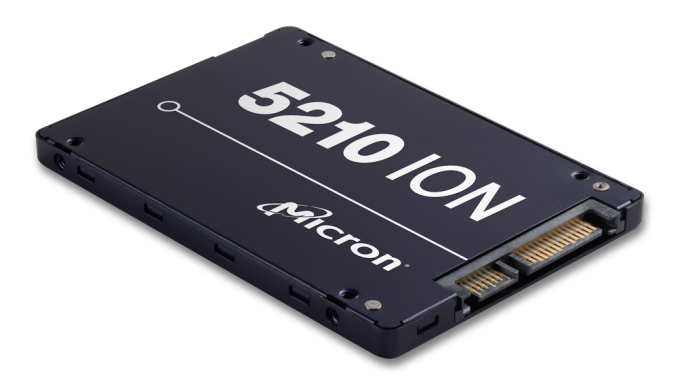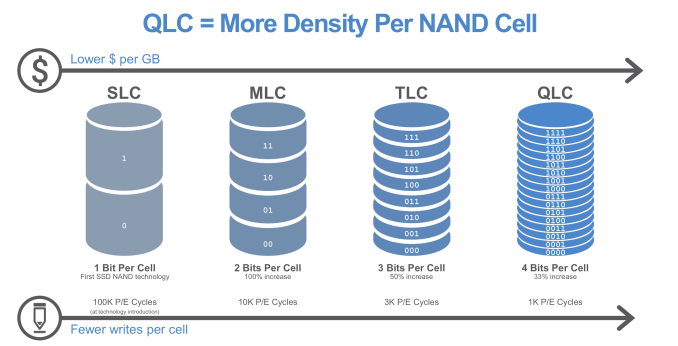Intel And Micron Launch First QLC NAND: Micron 5210 ION Enterprise SATA SSD
by Billy Tallis on May 21, 2018 4:30 PM EST
Intel and Micron are announcing today that their jointly-developed QLC NAND flash memory is now available, and Micron is now shipping the first solid state drive based on QLC NAND: an enterprise SATA drive branded the 5210 ION series. This will join the TLC-based 5200 family as a lower-cost tier with reduced write performance and endurance.
QLC NAND flash memory stores four bits of data per memory cell, providing a 33% capacity boost over three bit per cell TLC NAND, which is now used in almost all SSDs. The downsides are that QLC NAND has lower write endurance on the order of 1000 program/erase cycles, and lower write performance. Both of these are consequences of the difficulty of discriminating between 16 possible voltage levels within a memory cell, as compared to the 8 voltage levels required to store three bits per cell.
The cost reduction brought by QLC NAND is a much-awaited advance for enterprise storage. Most NAND flash manufacturers have started sampling QLC NAND within the past year, generally built on the same 64-layer 3D NAND processes that current-generation TLC NAND uses. Micron has previously shown wafers of 512Gb 64-layer QLC when announcing the addition of QLC to their roadmap, but today they are also announcing a 1Tb 64L QLC part—the first 1Tb memory chip to hit commercial availability. That 1Tb part is organized as four planes that can be processing I/O commands in parallel, compared to two planes for previous Intel/Micron NAND parts. This helps offset most of the performance loss associated with increasing per-die capacity. Thanks to the "CMOS under the array" design of Intel/Micron 3D NAND, the extra peripheral circuitry requried by doubling the number of planes doesn't add much to the overall die size.
It was initially feared that QLC write endurance would be low enough that drives would need to be treated more or less as write-once, read-many (WORM) devices, requiring careful handling on the software side. With multiple manufacturers now rating their QLC NAND for around 1k P/E cycles, it is clear that QLC-based SSDs aren't too fragile and can handle many existing workloads without needing major software changes to reduce writes.
Micron is primarily marketing the 5210 ION SSDs as replacement for hard drives, rather than replacements for any existing tier of enterprise SSD products. In this role, the 5210 ION will have clear advantages in density (with 2-8TB per 2.5" drive) and performance. QLC NAND only provides incremental improvements to cost, so the 5210 ION won't be matching 7200RPM hard drives for price per GB, but 10k RPM drives will probably be feeling the pressure, especially from TCO calculations that take into account the power efficiency advantages of SSDs.
Micron isn't providing detailed specifications for the 5210 ION series at this time, but we can read between the lines. The 5210 ION series is based on the same controller and firmware platform used for the 5200 and 5100 families. That means a Marvell 88SS1074 controller, and Micron-written firmware with features like their FlexCapacity configurable overprovisioning to trade capacity for performance and endurance.
| Write Endurance (Drive Writes Per Day) |
|||||
| Capacity | 5210 | 5200 | |||
| ION | ECO | PRO | MAX | ||
| 240 GB | 5.0 | ||||
| 480 GB | 1.0 | 5.0 | |||
| 960 GB | 1.0 | 1.3 | 5.0 | ||
| 1920 GB | <1 | 1.0 | 1.7 | 5.0 | |
| 3840 GB | <1 | 1.1 | 2.5 | ||
| 7680 GB | <1 | 0.6 | |||
Specific performance numbers haven't been disclosed, but Micron has indicated that both random and sequential read performance will be comparable to the 5200 family—meaning the 5210 can saturate the SATA link at higher queue depths. Write performance will be lower than the 5200 ECO but still higher than what a hard drive can deliver, especially for random writes.
The most important question is what the write endurance of the new QLC-based SSDs will be. The 5210 ION's endurance rating will be less than that of the 5200 ECO, which is rated for around 1 DWPD in most capacities. Micron indicates that their QLC NAND is good for around 1k Program/Erase cycles, which suggests a limit of at most about 0.5 DWPD before write amplification is taken into account. This is still higher than many consumer SSDs, where 0.3 DWPD is a typical rating for entry-level SATA SSDs with 3D TLC NAND.
When used for tasks where the performance of hard drives is currently adequate, the write endurance of the 5210 ION shouldn't be much of a problem. An endurance rating of about 0.1 DWPD would be sufficient for the 5210 ION to handle more random writes over its 5-year warranty than a hard drive can provide, but for sequential workloads it will still be possible to wear out the 5210 by writing to it at hard drive speeds. But Micron isn't recommending the 5210 ION for continuous video recording; instead they are pitching it for workloads that are at least 90% reads.
The Micron 5210 ION is now shipping to select customers with capacities from 1.92TB to 7.68TB, and will be broadly available this fall. Exact pricing and specifications will be released at that time. Intel has not yet announced any products using QLC NAND, but we expect product announcements and possibly shipments in time for Flash Memory Summit in August.
Intel and Micron are also working on their next generation 3D NAND manufacturing process, which increases the layer count to 96. This will provide a bigger density boost than a switch from TLC to QLC. It appears that development is currently focused on 96L TLC parts of unspecified capacity, but they will surely be followed by 96L QLC parts as well. Beyond 96 layers, Intel and Micron's long-standing partnership in flash memory technology will come to an end, with the two companies developing their flash independently. Neither company has shared any roadmap information going past this split, so it is not clear to what extent their designs will diverge with what will probably be the 128-layer generation.
Source: Micron











38 Comments
View All Comments
ಬುಲ್ವಿಂಕಲ್ ಜೆ ಮೂಸ್ - Monday, May 21, 2018 - link
How lame is that?theeldest - Monday, May 21, 2018 - link
Not lame? Cheaper SSDs are always a good thing, right?If the first customers are enterprise customers you can bet that the first consumer drives will actually be pretty good. I certainly don't need a drive with multiple "drive write per day" much less more than 1 drive write per month...
MamiyaOtaru - Tuesday, May 22, 2018 - link
yeah great, cheap out on storage for your data - the most important thing on the machineCheapSushi - Tuesday, May 22, 2018 - link
This comment makes zero sense. Are you running your system off SLC NAND drives? Eh. Anyone that cares about their data is using redundancy schemes like hard or software RAID/ZFS/StorageSpaces and following the 3-2-1 rule (with cloud backup). QLC NAND is PERFECT for bulk storage, for a capacity tier. Or are you too simple minded to think anyone would have more than 1 drive in their system? Intel 3D Xpoint (phase change) and Samsung's Z-NAND (SLC mode) will take over for performance tiers. While TLC will probably stay around for consumers with a balance of price, capacity and performance. Even with 1K P/E cycles and 0.5 writes per day, using QLC NAND for capacity / bulk storage sounds like a hell of a lot better for prosumers/enthusiasts than anything platter based. I'd say platters are more "cheap out on storage for your data" than anything else. .Samus - Tuesday, May 22, 2018 - link
Cheap out on storage? You are implying a technology that technically isn't even available at retail yet is unreliable.Considering how long they have been sampling QLC for QA (since last year) and Micron's track record for legendary NAND reliability, the drives, especially paired with a Marvell controller, will likely be more reliable than any magnetic storage medium hence it's enterprise focus for bulk cold storage where write performance will still exceed most hard disks and read performance will exceed any hard disk.
If QLC is what it takes for the death knell to hard drives, then QLC is what it takes. I'd trust my data on NAND over spinning glass any day.
ಬುಲ್ವಿಂಕಲ್ ಜೆ ಮೂಸ್ - Tuesday, May 22, 2018 - link
Depends on what you mean by "Cold Storage" SamusI can unplug and put "quality" hard drives into storage today and be assured the data is still there in 100 months
These new QLC SSD's on the other hand can be unplugged for up to 3 months an still be assured your data is still there
So, until the new tech can retain data as long as old tech, I'll keep irrelevant data on the fastest SSD, massive Volumes of what I want to keep on hard disk, and critical data on M-Disk (and hard disk)
Billy Tallis - Tuesday, May 22, 2018 - link
Retention for three months is guaranteed for a drive that's burned through its entire write endurance rating. If you're using the drive primarily as an archive drive and not using much of the write endurance, then data retention will be years instead of months.ಬುಲ್ವಿಂಕಲ್ ಜೆ ಮೂಸ್ - Tuesday, May 22, 2018 - link
OK, thanksHow many years would you trust YOUR data to a brand new one of these unplugged?
ಬುಲ್ವಿಂಕಲ್ ಜೆ ಮೂಸ್ - Tuesday, May 22, 2018 - link
Sorry Billy, but you cannot truthfully claim years of data retention without errors until you have tested it for years without errorI don't think you can simply extrapolate error free data life expectancy from accelerated temperature extremes on these drives
peevee - Thursday, May 24, 2018 - link
1000 cycles is good enough for 99.99%+ of home users with modern controllers (DRAM & SLC cache & wear leveling).They'd better make their parts more parallel to reach 4xPCIe3 limit (4GB/s please) already. 1-2TB m.2 PCIex4 at 4GB/s is what doctor ordered.